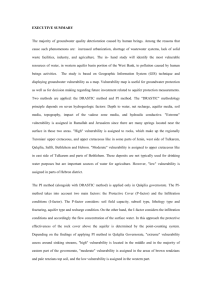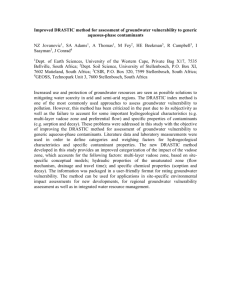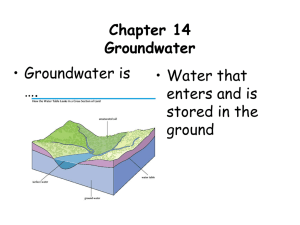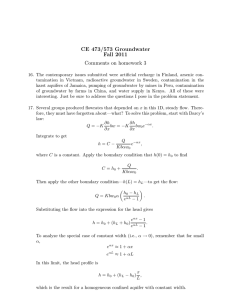Application of DRASTIC Model in Sensibility of
advertisement
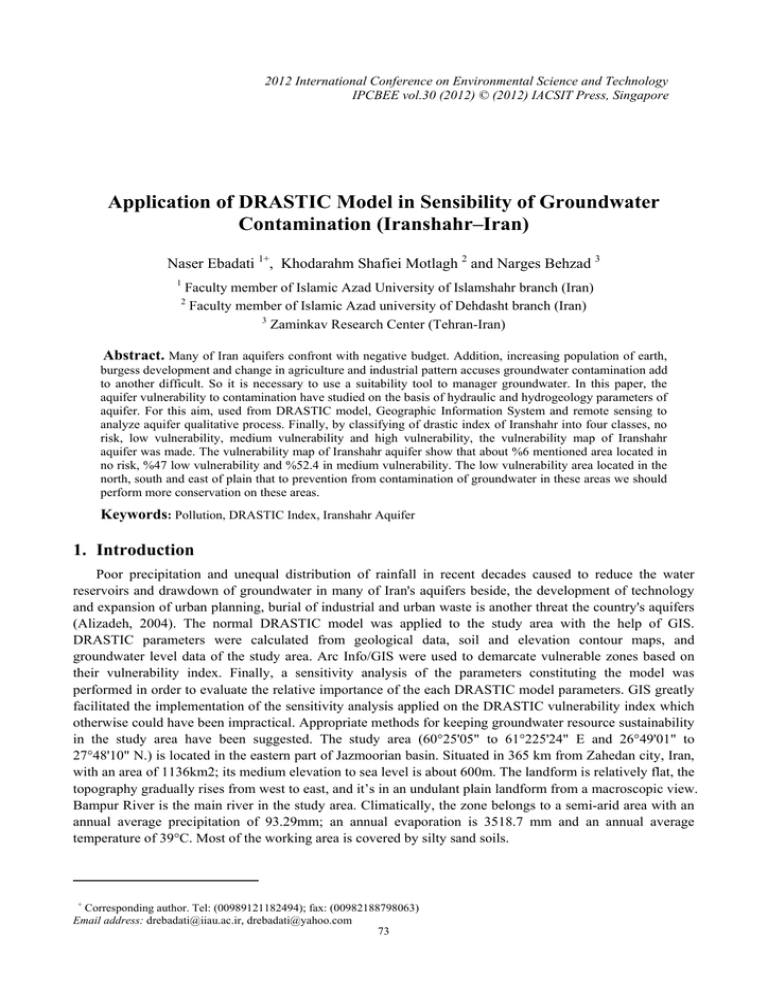
2012 International Conference on Environmental Science and Technology IPCBEE vol.30 (2012) © (2012) IACSIT Press, Singapore Application of DRASTIC Model in Sensibility of Groundwater Contamination (Iranshahr–Iran) Naser Ebadati 1+, Khodarahm Shafiei Motlagh 2 and Narges Behzad 3 1 Faculty member of Islamic Azad University of Islamshahr branch (Iran) Faculty member of Islamic Azad university of Dehdasht branch (Iran) 3 Zaminkav Research Center (Tehran-Iran) 2 Abstract. Many of Iran aquifers confront with negative budget. Addition, increasing population of earth, burgess development and change in agriculture and industrial pattern accuses groundwater contamination add to another difficult. So it is necessary to use a suitability tool to manager groundwater. In this paper, the aquifer vulnerability to contamination have studied on the basis of hydraulic and hydrogeology parameters of aquifer. For this aim, used from DRASTIC model, Geographic Information System and remote sensing to analyze aquifer qualitative process. Finally, by classifying of drastic index of Iranshahr into four classes, no risk, low vulnerability, medium vulnerability and high vulnerability, the vulnerability map of Iranshahr aquifer was made. The vulnerability map of Iranshahr aquifer show that about %6 mentioned area located in no risk, %47 low vulnerability and %52.4 in medium vulnerability. The low vulnerability area located in the north, south and east of plain that to prevention from contamination of groundwater in these areas we should perform more conservation on these areas. Keywords: Pollution, DRASTIC Index, Iranshahr Aquifer 1. Introduction Poor precipitation and unequal distribution of rainfall in recent decades caused to reduce the water reservoirs and drawdown of groundwater in many of Iran's aquifers beside, the development of technology and expansion of urban planning, burial of industrial and urban waste is another threat the country's aquifers (Alizadeh, 2004). The normal DRASTIC model was applied to the study area with the help of GIS. DRASTIC parameters were calculated from geological data, soil and elevation contour maps, and groundwater level data of the study area. Arc Info/GIS were used to demarcate vulnerable zones based on their vulnerability index. Finally, a sensitivity analysis of the parameters constituting the model was performed in order to evaluate the relative importance of the each DRASTIC model parameters. GIS greatly facilitated the implementation of the sensitivity analysis applied on the DRASTIC vulnerability index which otherwise could have been impractical. Appropriate methods for keeping groundwater resource sustainability in the study area have been suggested. The study area (60°25'05" to 61°225'24" E and 26°49'01" to 27°48'10" N.) is located in the eastern part of Jazmoorian basin. Situated in 365 km from Zahedan city, Iran, with an area of 1136km2; its medium elevation to sea level is about 600m. The landform is relatively flat, the topography gradually rises from west to east, and it’s in an undulant plain landform from a macroscopic view. Bampur River is the main river in the study area. Climatically, the zone belongs to a semi-arid area with an annual average precipitation of 93.29mm; an annual evaporation is 3518.7 mm and an annual average temperature of 39°C. Most of the working area is covered by silty sand soils. + Corresponding author. Tel: (00989121182494); fax: (00982188798063) Email address: drebadati@iiau.ac.ir, drebadati@yahoo.com 73 2. Methodology In this study for mapping the vulnerability Iranshahr aquifer is used of the DRASTIC model and GIS.DRASTIC model is one of the tools created to protect groundwater that first introduced by Aller (Aller et al., 1987). Than developed by an agreement between the Environmental Protection Agency (EPA) and the International Water Resources Agency (RWWA).the name of DRASTIC model are derived from first letter hydrologic parameters. DRASTIC is an empirical groundwater model that estimates groundwater contamination vulnerability of aquifer systems based on the hydrogeological settings of that area (Aller, et al., 1987). The DRASTIC hydrogeological vulnerability ranking method uses a set of seven hydrogeologic parameters to classify the vulnerability or pollution potential of an aquifer. The parameters are: - Depth of groundwater (D); - Recharge rate (R); - the Aquifer media (A); - the Soil media (S); - Topography (T); - the Impact of the vadose zone (I); and- the hydraulic Conductivity of the aquifer (C).Each parameter is assigned a relative weight from one to five based on its relative susceptibility to pollutant (Shamsuddin, 2000) (Similarly, parameter rankings are assigned on a scale of one to ten and are based on its significance to pollution potential in an assessed area. The set of variables that are considered for the DRASTIC model can be grouped according to three main categories: land surface factors, unsaturated zone factors and aquifer or saturated zone factors. The aquifer media properties and the hydraulic conductivity are the critical factors identified for the saturated zone. The depth to water and the properties of the vadose zone characterize the water/contaminant path down to the saturated zone (Dirk et al., 1997). In soil and the unsaturated zone, some mechanisms may affect the contaminant concentration much more than in the saturated zone (Gogu et al, 2000). The DRASTIC Index was computed by summing the weighted factors of each subdivision of the area. Generally, higher DI value indicates greater susceptibility to groundwater pollution: DRASTIC INDEX = (D W × Dr ) + ( RW × Rr ) + ( Aw × Ar ) + ( S w × S r ) + (Tw × Tr ) + ( I w × I r ) + (C w × Cr ) Using the above equation, DRASTIC index values were obtained. According to the ranges, the degree of vulnerability of each area was concluded; a groundwater vulnerability map was then designed to show the vulnerability toward contamination of each area. 3. Development of the DRASTIC parameters To produce deep layer have used of water level statistics of pizometers in plain. The range of depth water change from 50 meters in the eastern areas to 10 meters in west and southwest areas therefore the DRASTIC index of depth water layer increases from 5 in east to 25 in west of plan. By extent can be said that 28 percent of West plain ears has the numerical value 25 that is important to contamination. 3.1. Recharge net Two maps are required for the preparation of Recharge net. The first is a network of rainfall and second is map of surface permeability of the earth; by multiplying these two maps the Recharge layer can be produced. Given that the average annual rainfall in this region is about 93/29 mm that according to the rate of DRASTIC ranking model is placed in two classes, so the rain network for plain were considered equal. Now Given that the rate of rain penetration depends on soil thus we provided the land use of region. Finally recharge layer provided by multiplying these two maps. The numerical value of Recharge network is little all over plain due to low rainfall region. Four Numerical values resulted for urban area because of low influence and 12 for the rest of the plain and can be said this amount of recharge has very little talent in ground water contamination. 3.2. Aquifer Media For preparing this layer is used from information of the column wells in the plain area. The map for the Aquifer media ranking was obtained from an interpolation of the lithology of the aquifer of each borehole. The rating for each medium was adjusted based on the characteristic of the zone. Conversely, Lower ratings were assigned to the fine textured media. The numerical value for Aquifer Map was calculated between 10 74 and 30 that more value is related to West eras of Plain. In the other hands, can be said that West plains area has higher talent than other areas. 3.3. Soil Media In order to prepare the soil layers are helped from satellite image region and ENVI software and according to classify and ranking. Map of surface soil in integrated land use indicate that soil in the western area and around of bampur river due to cultivation and work is more developed than east eras and can be said that pollution talent in the eastern region is higher than other parts due to the coarse texture of soil. Numerical values were calculated for the soil layer between 6 and 20. 3.4. Topographic layer Topography expresses the slope and slope variability of the land surface. A high degree of slopes increases the runoff capacity. As the infiltration probability of contaminant is lessened, the groundwater pollution potential decreases. Procedures for data preparation and analysis this layer concludes under steps: 1. Create surface elevation raster data from the contour shape file using Spatial Analysis Tools – Interpolation – Topo to Raster. 2. Create a surface percent slope raster file using Spatial Analyst – Surface Analysis – Slope. 3. Since the study area is relatively flat, the range 0 to 2% slope is predominant. Numerical values were calculated for the thin layer 4 to 12. The mapping of the topography was the easiest process because the data required for this parameter were easy to find and didn’t need many modifications. The slope map was generated using 3D analyst tool of Arcmap. 3.5. Impact of the Vadose Zone Media For preparing the layers were used from information of well logs in the plain as well as soil media. Lithology of the semi-saturated layer is including mixture of sand and gravel in the eastern eras that toward west is added alternatively to it silt and clay and the western is more silt and clay. Numerical values calculated for this layer was calculated between15 to 45 and can be said potential contamination within the western and south-west is less than other parts. 3.6. Conductivity An aquifer with high conductivity is vulnerable to substantial Contamination as a plume of contamination can move easily through the aquifer (Rahman A, 2007). Hence, areas with high hydraulic conductivity values are more susceptible to contamination. Hydraulic conductivity of an aquifer shows the groundwater mobility potential in saturated environment so pollutants mobility potential carried by the groundwater is approximately equal to hydraulic conductivity (Civita and Maio, 1995). Hydraulic conductivity depends on the degree of relationship of porous between rock environments. This factor controls pollutants movement from the point of penetration to reach the saturated zone. Therefore, the areas with high hydraulic conductivity are more potential to create pollution. Conductivity layer can be provided based on data from pumping test wells in the study area. Given that the hydraulic conductivity of Iranshahr aquifer previously was prepared by Mrs. Shahabifard using of software Mad flow (Shahabifard, 2004) so in this study for preparation of the conductivity layer is used it. Then, it was compared with interpolation maps of hydraulic conductivity from pumping wells. Numerical values calculated for the layer between 6 and 30. Hydraulic conductivity in the southeast and north and northwest areas is higher than other parts so can be said that talented of infection is higher in these parts. 4. Vulnerability mapping of Iranshahr aquifer The final raster for the Overall Vulnerability Index was created using the raster calculator in Spatial Analyst tools by combining the seven hydrogeological data layers as illustrated in figure 1. Referring to Aller et al. (1987), the final step of the vulnerability mapping consists of reclassifying the DRASTIC indexes and assigning to each group its degree of vulnerability; thereafter, groundwater vulnerability map of aquifer Iranshahr was developedSince the ratio of the weightings to consider layers is different, so it is necessary having a criterion for comparison and confirms the correct composition. The theoretical model has presented by Aller and Bennett (Aller et al., 1987), the desired weights for nitrate ions have been calibrated therefore can be used for measuring in other regions. 75 Fig. 1: Vulnerability mapping Also, for verification of final vulnerability map, can be used of fluoride contaminant data. (A. Moghaddam et al, 2010). For this reason, for sensitivity analysis of the model was used nitrate ions. For this purpose, the number seven spot with a good dispersion in the study area were obtained from the Department of Water of Zahedan city. Six samples were consistent with the model. Given that this study gives us a model that shows the contamination potential so can be said the point of nitrate not match to model, it means that probably intensity pollution to be different there to other parts locally. Besides, none of the point with high nitrate contamination locates in low vulnerability eras this can confirmed the accuracy of the model (Figure 2). For this purpose, ratio of nitrate concentration to drastic index calculated that whatever the ratio for all point be closer together can be resulted that model is more accurate. Table 2 shows the numerical values of drastic and nitrate concentration for seven points in the plain area. As is clear from the table the value Q (ratio of nitrate to the number DRASTIC) for six points is close and one point (located within the urban area) is slightly different. So this shows that six points from seven-point is adjusted with model so can be said that the model accuracy is about 83 percent. Fig. 2: A: Sensitivity analysis layer, B: distribution of points above the local DRASTIC index map Table 2: shows the numerical values of drastic and nitrate concentration for seven points in the plain area 76 Q= Nitrate D − Index Drastic index nitrate concentration (ppm) water type 0/17 105 16/72 - 0/15 100 15/24 Cl-Na 0/18 145 27/28 - 0/25 125 31/27 Cl - Na 0/17 121 20/97 Cl - Na 0/13 115 14/52 SO4 - Na 0/11 130 14/12 HCO3 - Na UTM 255000E 3005000N 260000E 3008000N 263100E 3010500N 270770E 3011200N 274000E 3009600N 275000E 3013000N 276640E 3006000N place Sampling Mohammad-abad Back of bampur dam sarhang Shahid beheshti chabahar road zaboli road sarkahoran 5. Conclusion As was previously expressed purpose of this study was provided groundwater vulnerability map of Iranshahr plain DRASTIC index for Iranshahr Plain is calculated between 65 and 155 that is placed most low to moderate range. Regarding to the drastic index, about 0.6% of the study area has no risk, 47% low vulnerability risk, 52.4% is moderately vulnerable class. The moderate vulnerability class is situated in the north, west and west south area that can be said these parts should be care and control to prevent contamination of ground water. Finally, can be said the model plain, besides helping managers of water resource in decisions can be guide other mangers in other organization such as construction and urban development. 6. References [1] A. Alizadeh, Principles of Applied Hydrology, Astan Qds Razavi publications.2004, P 254. [2] L. Aller , T. Bennett, J.H. Lehr, R.J. Petty and G. Hackett, DRASTIC: a standardized system for evaluating ground water pollution potential using hydrogeologic settings, United States Environ Prot Agency, Ada, Oklahoma74820, EPA 600/2-85/018, 1987 p455. [3] K. Dirk De, C. Marco, P. Roberto, A. Ayed, B.M. Abdullah And M. Yacine, A computerized methodology for aquifer vulnerability mapping: Mean Sea Level aquifer, Malta and Manouba aquifer, Tunisia. Karst Hydrology (Proceedings of Workshop W2 held at Rabat, Morocco, April-May IAHS Publ. no. 247, 1997. 81. [4] R.C. Gogu, A. Dassargues. Current trends and future challenges in groundwater vulnerability assessment using overlay and index methods. Environmental Geology, 39 2000 (6):549- 559. [5] M. Civita, and M. De Maio. Mapping groundwater vulnerability in areas impacted by flash food disasters. Bull. GEAM 32, 4, 1995, pp. 233-238. [6] F. Shahabi Fred, Affects drawdown of Iranshahr aquifer on the flow of Bampur River using of MODFLOW mathematical model, Thesis, University of Sistan&Baluchestan.,2004, P 321. [7] A. Moghaddam, E. Fijani, A. Nadiri, Groundwater Vulner ability Assessment Using GIS-Based DRASTIC Model in the Bazargan and Poldasht Plains, Journal of Environmental Studies, Vol. 35, No. 52.2010, PP110. [8] H. Fanomezantsoa, Z. Jianwei. And G. Luo. Regional assessment of groundwater vulnerability in Tamtsag basin, Mongolia using drastic model, Journal of American Science. 2010;6(11):65-78. [9] W. Fred, B. Tim, and W. Dana. Kolpin. Groundwater vulnerability: interactions of chemical and site properties. The Science of the Total Environment 299, 2002, 131-143. [10] G.F.B. Carter, Geographic information system for geoscience. USA: Oxford, Pergamon Press, 1993. [11] M. Chitsazan, and Y. Akhtari, A GIS-based DRASTIC Model for Assessing Aquifer Vulnerability in Kherran Plain, Khuzestan, Iran, Water Resources Management , Volume 23, Number 6, 2006, 1137-1155. 77
